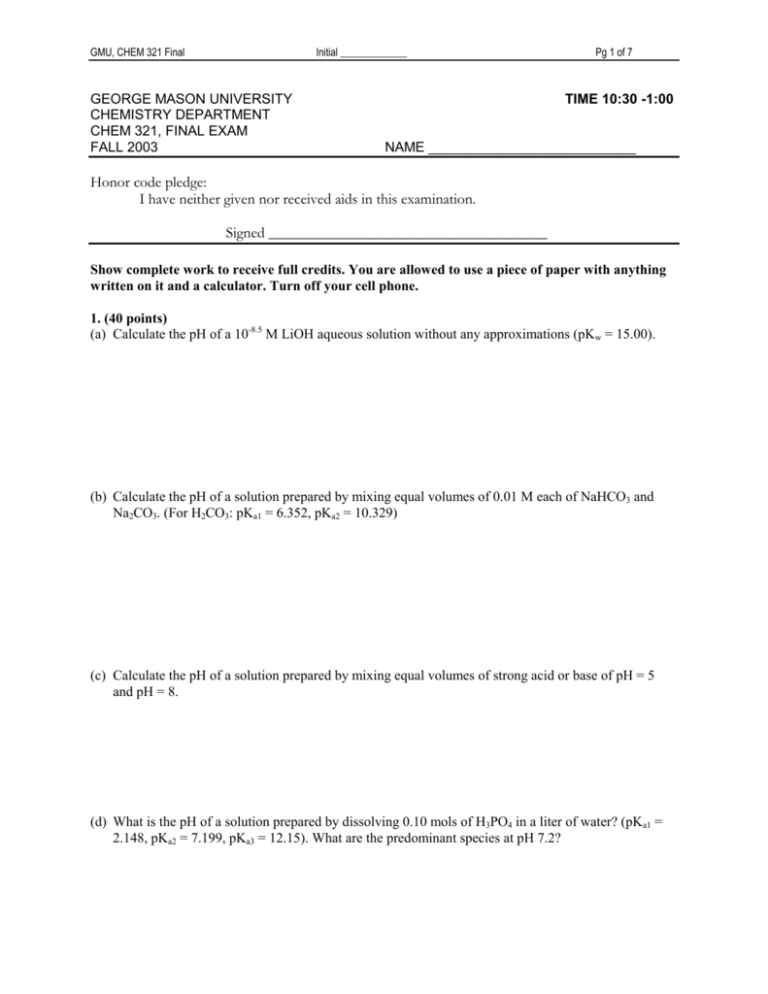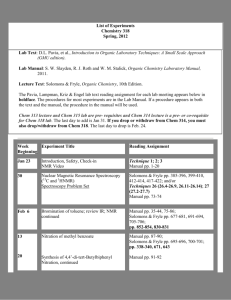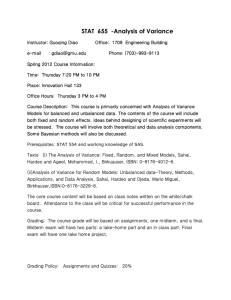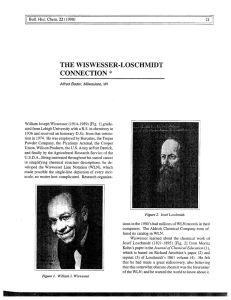Example final exam - George Mason University
advertisement

GMU, CHEM 321 Final Initial _____________ GEORGE MASON UNIVERSITY CHEMISTRY DEPARTMENT CHEM 321, FINAL EXAM FALL 2003 Pg 1 of 7 TIME 10:30 -1:00 NAME ___________________________ Honor code pledge: I have neither given nor received aids in this examination. Signed _____________________________________ Show complete work to receive full credits. You are allowed to use a piece of paper with anything written on it and a calculator. Turn off your cell phone. 1. (40 points) (a) Calculate the pH of a 10-8.5 M LiOH aqueous solution without any approximations (pKw = 15.00). (b) Calculate the pH of a solution prepared by mixing equal volumes of 0.01 M each of NaHCO3 and Na2CO3. (For H2CO3: pKa1 = 6.352, pKa2 = 10.329) (c) Calculate the pH of a solution prepared by mixing equal volumes of strong acid or base of pH = 5 and pH = 8. (d) What is the pH of a solution prepared by dissolving 0.10 mols of H3PO4 in a liter of water? (pKa1 = 2.148, pKa2 = 7.199, pKa3 = 12.15). What are the predominant species at pH 7.2? GMU, CHEM 321 Final Initial _____________ Pg 2 of 7 (e) Excess PbBr2(s) was added to 0.025 M NaBr solution. Analysis of the equilibrium solution showed [Pb2+] = 1.40 x 10-2 M. What is the Ksp for PbBr2(s)? (f) The metal ions, Zn2+ , is titrated with EDTA. If the concentration of the complex at the equivalence point is 0.025 M, calculate the concentration of free EDTA present in the solution. (αY4- = 0.36, Kf = 109) (g) Show that the response of a Cu2+ ions selective electrode changes by 29.6 mV for a 10-fold change in concentration. (h) Solid BaF2 is in equilibrium with its species in aqueous solution. Identify all the species in solution and write the same number of equations to solve for the species concentrations. (mass balance, charge balance etc.) GMU, CHEM 321 Final Initial _____________ Pg 3 of 7 2. (15 points) The graph below is the fractional composition diagram for a polyprotic acid (HnA). Given the initial concentration of the acid is 0.002 M, answer the following questions: (a) Find n. Identify and estimate the acid dissociation constants. (b) Calculate the equilibrium concentrations of all acidic or basic species at pH 2, pH 5, pH 7, and at pH 12. (c) Identify two pH values where the buffer capacities of the acid are maximum 1.2 1 Fraction 0.8 0.6 0.4 0.2 0 0 2 4 6 8 pH 10 12 14 16 GMU, CHEM 321 Final Initial _____________ Pg 4 of 7 3. (15 points) The following reaction can be studied by means of an electrochemical cell. 3 AgCl (s) + Al(s) == 3Ag (s) + Al3+ (aq) + 3Cl- (aq) Given, Al3+ + 3e- == Al(s) AgCl(s) + e- == 2Ag(s) + 2Cl- (aq) Eo = - 1.660 V Eo = 0.222 V (a) Draw an electrochemical cell showing all the components of the cell and the direction of electron flow. (b) Express the cell using line notation (c) Calculate the equilibrium constant for the cell at 25 oC (d) Calculate the concentration of Al3+ in the cell if the cell has 0.010 M KCl and the cell voltage is 2.000 V. GMU, CHEM 321 Final Initial _____________ Pg 5 of 7 4. (30 points) Briefly answer the following questions: a) Explain why one term of the van Deemeter equation depends on v and why one term depends on 1/v. What are these terms called? b) Explain the function and the need for a suppressor column in ion chromatography. c) Explain how the following separation was obtained. d) A nonpolar mobile phase in reversed phase HPLC decreases the retention of less polar solutes like benzene. Explain why. e) What is the difference between fluorescence excitation spectrum and fluorescence emission spectrum? Which one resembles an absorption spectrum? GMU, CHEM 321 Final Initial _____________ Pg 6 of 7 f) Explain how electroosmotic flow drives the solution (solute+solvent) in a CZE separation of ionic species. g) Explain how the following detector works? h) The solvent hexane was used to prepare a standard solution of benzene by dissolving 30.0 mg of benzene (FW 78.114) in 250.0 mL of hexane. The sample has an absorbance of 0.312 at 256 nm in a 1.000 cm cell. Find the molar absorptivity of benzene. GMU, CHEM 321 Final Initial _____________ Pg 7 of 7 Extra Points 1. (10 points) A 1.000 g sample of an alloy steel sample is dissolved in perchloric acid, the manganese is oxidized to permanganate (purple in color), and the solution is diluted to 250.0 mL in a volumetric flask. The absorbance at 525 nm in a 1.00 cm cell is found to be 0.35. Calculate the percentage of Mn is steel. (Molar absorptivity of permanganate, MnO4-, is 2390. Atomic weight of Mn = 55) 2. (10 points) Consider a 100.0 mL 0.10 M aqueous solution of NaHCO3. (Data: H2CO3: pKa1 = 6.35, pKa2 = 10.33) (a) Identify all the species present in solution (b) Calculate the pH of the solution. (c) What is the pH of the solution if 10.0 millimols of HCl is added to it?








